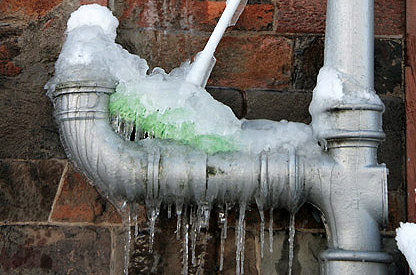Tips to Defend Plumbing System from Cold Weather: Critical Strategies
Tips to Defend Plumbing System from Cold Weather: Critical Strategies
Blog Article
Do you find yourself on the lookout for information and facts concerning 6 Ways to Prevent Frozen Pipes?

Cold weather can damage your plumbing, particularly by freezing pipes. Below's exactly how to prevent it from taking place and what to do if it does.
Introduction
As temperature levels drop, the risk of icy pipes boosts, possibly causing costly fixings and water damage. Understanding just how to stop icy pipelines is crucial for homeowners in chilly environments.
Avoidance Tips
Protecting at risk pipes
Wrap pipelines in insulation sleeves or make use of warm tape to safeguard them from freezing temperature levels. Focus on pipelines in unheated or outside areas of the home.
Home heating techniques
Maintain interior areas appropriately warmed, especially locations with plumbing. Open up cupboard doors to enable warm air to circulate around pipes under sinks.
How to determine icy pipes
Search for lowered water circulation from faucets, unusual odors or sounds from pipelines, and visible frost on exposed pipes.
Long-Term Solutions
Structural modifications
Consider rerouting pipes far from exterior wall surfaces or unheated locations. Include extra insulation to attics, cellars, and crawl spaces.
Updating insulation
Invest in top quality insulation for pipelines, attic rooms, and walls. Proper insulation assists maintain constant temperatures and lowers the danger of frozen pipes.
Protecting Exterior Pipes
Garden pipes and outside taps
Disconnect and drain garden hoses prior to winter months. Mount frost-proof spigots or cover exterior taps with insulated caps.
Comprehending Frozen Pipes
What creates pipes to ice up?
Pipelines ice up when subjected to temperature levels listed below 32 ° F (0 ° C) for extended periods. As water inside the pipes ices up, it increases, putting pressure on the pipe walls and possibly causing them to burst.
Dangers and problems
Frozen pipelines can lead to water supply disruptions, building damages, and costly repair work. Burst pipelines can flood homes and trigger substantial structural damage.
Signs of Frozen Pipes
Identifying icy pipes early can avoid them from breaking.
What to Do If Your Pipelines Freeze
Immediate activities to take
If you believe frozen pipes, maintain faucets open up to soothe pressure as the ice thaws. Use a hairdryer or towels taken in warm water to thaw pipelines slowly.
Verdict
Protecting against frozen pipelines calls for aggressive procedures and quick responses. By recognizing the causes, indications, and safety nets, homeowners can protect their plumbing during cold weather.
6 Proven Ways to Prevent Frozen Pipes and Protect Your Home
Disconnect and Drain Garden Hoses
Before winter arrives, start by disconnecting your garden hoses and draining any remaining water. Close the shut-off valves that supply outdoor hose bibs and leave the outdoor faucet open to allow any residual water to drain. For extra protection, consider using faucet covers throughout the colder months. It’s also important to drain water from any sprinkler supply lines following the manufacturer’s directions.
Insulate Exposed Pipes
Insulating your pipes is an effective way to prevent freezing. Pipe insulation is readily available at home improvement stores and is relatively inexpensive. Pay close attention to pipes in unheated areas such as the attic, basement, crawl spaces, or garage. Apply foam insulation generously to create a buffer against the cold. You can also wrap your pipes in heat tape or thermostat-controlled heat cables for added warmth.
Seal Air Leaks
Inspect your home for any cracks or openings that could let in cold air. Seal any holes around the piping in interior or exterior walls, as well as the sill plates where your home rests on its foundation. Additionally, make sure to keep your garage door closed unless you’re entering or exiting. Leaving it open creates a significant air leak that can lead to frozen pipes.
Allow Warm Air Circulation
During cold snaps, it’s essential to allow warm air to circulate evenly throughout your home. Leave interior doors ajar to promote better airflow. Open kitchen and bathroom cabinets to help distribute heat consistently around the rooms. If you have small children or pets, be sure to remove any household chemicals or potentially harmful cleaners from open cabinets for safety.
Let Faucets Drip
A small trickle of water can make a big difference in preventing ice formation inside your pipes. When temperatures drop significantly, start a drip of water from all faucets served by exposed pipes. This continuous flow helps prevent the water from freezing. Additionally, running a few faucets slightly can relieve pressure inside the pipes, reducing the chances of a rupture if the water inside does freeze.
https://choateshvac.com/6-proven-ways-to-prevent-frozen-pipes-and-protect-your-home/

Do you enjoy more info about How to prepare your home plumbing for winter weather? Try to leave feedback further down. We will be glad to listen to your ideas about this post. Hoping to see you back again before long. Enjoyed our blog? Please quickly share it. Let others find it. Thanks for being here. Please visit our website back soon.
Call Today Report this page